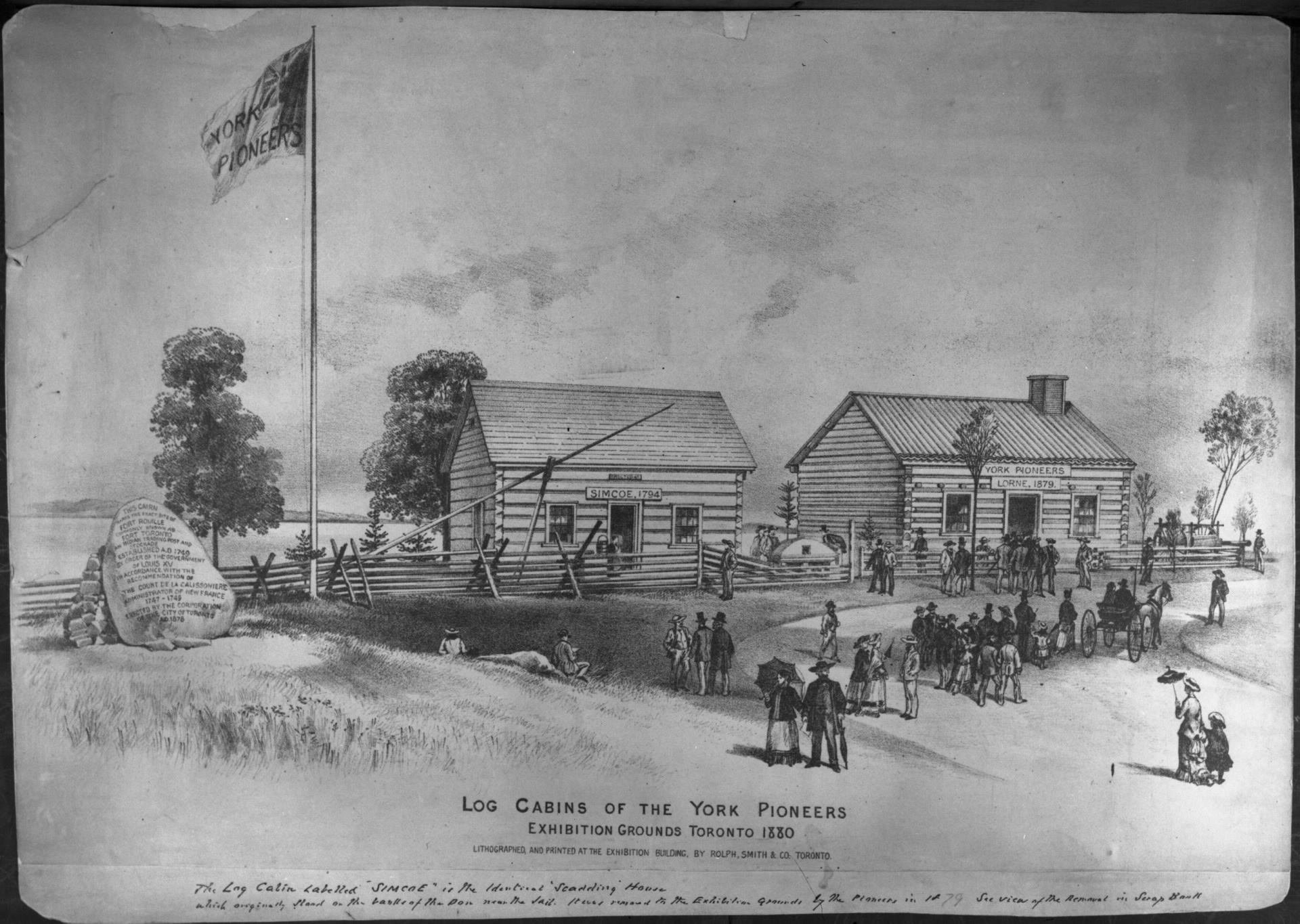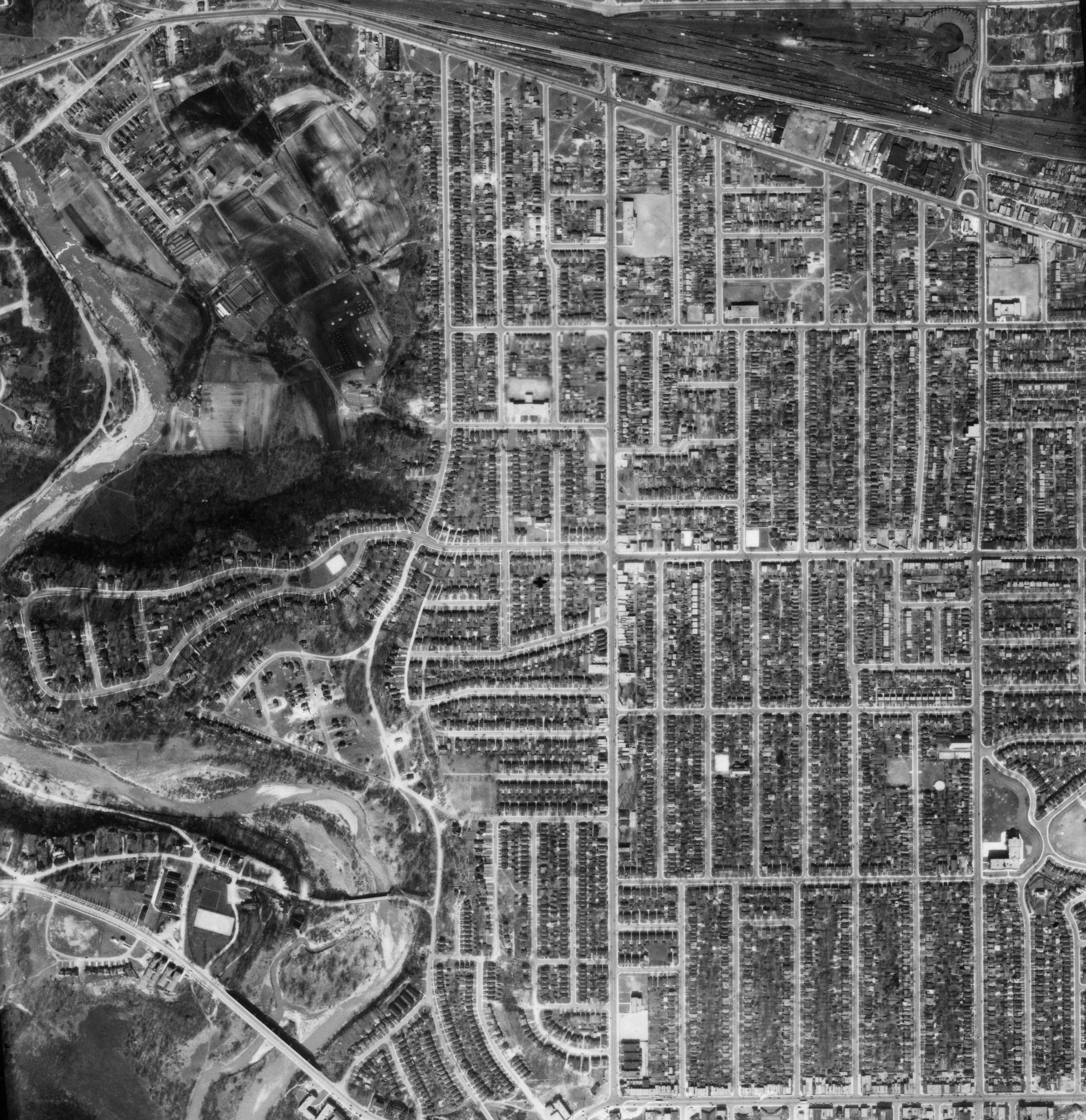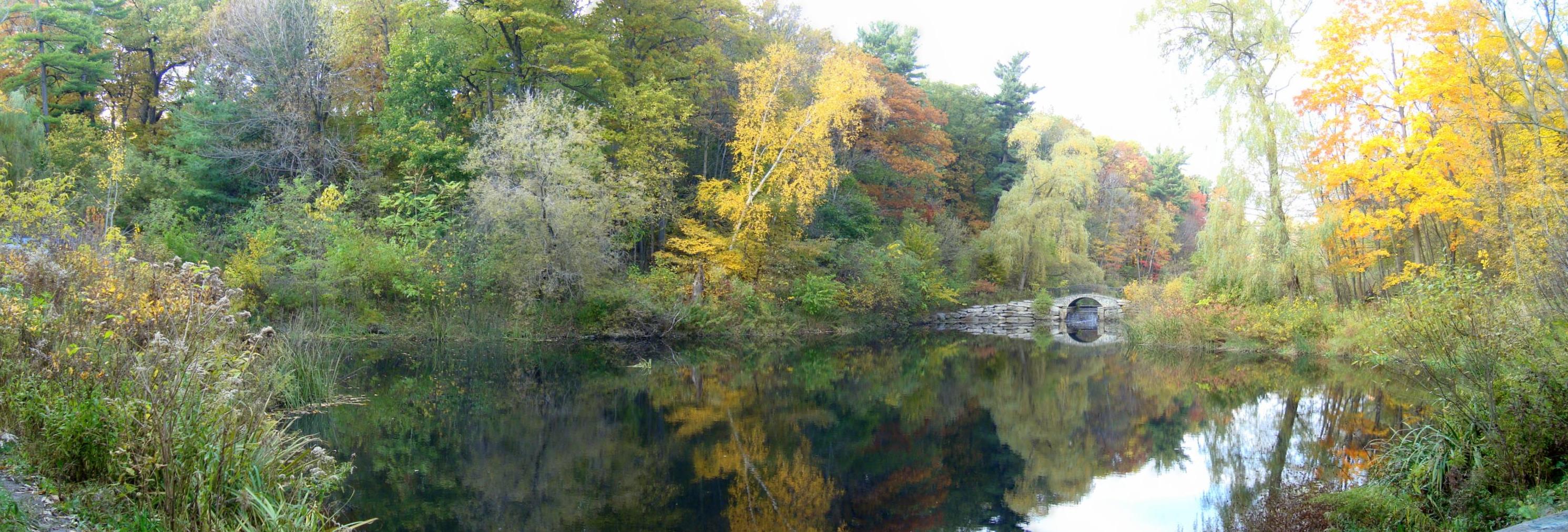|
Fort Rouillé
Fort Rouillé was a French trading post located in what is now Toronto, Ontario, Canada. Fort Rouillé was constructed by the French in 1751, building upon the success of a trading post they established in the area a year earlier, known as Fort Toronto. Fort Rouillé was named for Antoine Louis Rouillé, who at the time of its establishment was Secretary of State for the Navy in the administration of King Louis XV of France. It served as a trading post with the local indigenous peoples from the region. Fort Rouillé was evacuated and burnt down by its French garrison after the French defeat at Fort Niagara in July 1759, during the French and Indian War. The remains of the fort were demolished in the 19th century. The fort site is now part of the public lands of Exhibition Place. The location is marked by an obelisk monument, with the outline of the fort marked in concrete. History During the late 17th and 18th centuries, the area surrounding Toronto was frequently used by Fre ... [...More Info...] [...Related Items...] OR: [Wikipedia] [Google] [Baidu] |
Toronto
Toronto ( ; or ) is the capital city of the Canadian province of Ontario. With a recorded population of 2,794,356 in 2021, it is the most populous city in Canada and the fourth most populous city in North America. The city is the anchor of the Golden Horseshoe, an urban agglomeration of 9,765,188 people (as of 2021) surrounding the western end of Lake Ontario, while the Greater Toronto Area proper had a 2021 population of 6,712,341. Toronto is an international centre of business, finance, arts, sports and culture, and is recognized as one of the most multicultural and cosmopolitan cities in the world. Indigenous peoples have travelled through and inhabited the Toronto area, located on a broad sloping plateau interspersed with rivers, deep ravines, and urban forest, for more than 10,000 years. After the broadly disputed Toronto Purchase, when the Mississauga surrendered the area to the British Crown, the British established the town of York in 1793 and later d ... [...More Info...] [...Related Items...] OR: [Wikipedia] [Google] [Baidu] |
Baby Point
Baby Point is a residential neighbourhood in the York district of Toronto, Ontario, Canada. It is bounded on the west by the Humber River from south of Baby Point Crescent to St. Marks Road, east to Jane Street and Jane Street south to Raymond Avenue and Raymond Avenue west to the Humber. It is within the city-defined neighbourhood of 'Lambton-Baby Point.' Baby Point is within the proximity of Jane station. The neighbourhood was at one time an Iroquois village, called Teiaiagon. The village had a population of 5000 at its peak. The village was burnt to the ground in a French Army attack in 1687. In the 19th century, lawyer James Baby bought the land from the Upper Canada government, which had bought it as part of the Toronto Purchase. The land was developed into the current neighbourhood in the early 20th century. The name is pronounced by locals as "Bobby" or "Babby"to rhyme with tabby or cabbiein an approximation of how James Baby pronounced his surname. History The Baby ... [...More Info...] [...Related Items...] OR: [Wikipedia] [Google] [Baidu] |
Seven Years' War
The Seven Years' War (1756–1763) was a global conflict that involved most of the European Great Powers, and was fought primarily in Europe, the Americas, and Asia-Pacific. Other concurrent conflicts include the French and Indian War (1754–1763), the Carnatic Wars and the Anglo-Spanish War (1762–1763). The opposing alliances were led by Great Britain and France respectively, both seeking to establish global pre-eminence at the expense of the other. Along with Spain, France fought Britain both in Europe and overseas with land-based armies and naval forces, while Britain's ally Prussia sought territorial expansion in Europe and consolidation of its power. Long-standing colonial rivalries pitting Britain against France and Spain in North America and the West Indies were fought on a grand scale with consequential results. Prussia sought greater influence in the German states, while Austria wanted to regain Silesia, captured by Prussia in the previous war, and to conta ... [...More Info...] [...Related Items...] OR: [Wikipedia] [Google] [Baidu] |
Pierre Pouchot
Captain Pierre Pouchot (April 8, 1712 – 1769) was a French military engineer and officer in the French regular army. He was born at Grenoble, France, son of a merchant. In 1733 he joined the French Royal Army (1652–1830), regular army as a volunteer engineer and on May 1, 1734 was appointed a second lieutenant in the Regiment de Bearn. He later served in Italy, Flanders, and Germany and became an assistant adjutant within ten years. In the War of the Austrian Succession his engineering service won distinction and he received the Order of Saint Louis, Cross of the Order of St. Louis and in September, 1748 a Captain's commission. In 1754 during the French and Indian War his regiment was selected for service in Canada. He arrived at Fort Frontenac in July, 1755 and then was sent to Fort Niagara to improve its defenses. In July and August, 1756 he assisting in laying out the siege works in the Battle of Fort Oswego (1756), Battle of Fort Oswego. After came construction in Montre ... [...More Info...] [...Related Items...] OR: [Wikipedia] [Google] [Baidu] |
Fort Niagara
Fort Niagara is a fortification originally built by New France to protect its interests in North America, specifically control of access between the Niagara River and Lake Ontario, the easternmost of the Great Lakes. The fort is on the river's eastern bank at its mouth on Lake Ontario. Youngstown, New York, later developed near here. The British took over the fort in 1759 during the French and Indian War. Although the United States was ostensibly ceded the fort after it gained independence in the American Revolutionary War, the British stayed until 1796. Transfer to the U.S. came after signing of the Jay Treaty that reaffirmed and implemented the legal border with British Canada. Although the US Army deactivated the fort in 1963, the Coast Guard continues to have a presence here. A non-profit group operates the fort and grounds as a state park and preserves it in part as a museum and site for historical re-enactments. It is also a venue for special events related to the region' ... [...More Info...] [...Related Items...] OR: [Wikipedia] [Google] [Baidu] |
François Picquet
François Picquet (; 4 December 1708 – 15 July 1781) was a French Sulpician priest who emigrated to Montreal, Canada, in 1734. Early life Picquet was born in Bourg-en-Bresse, France, on 4 December 1708, the son of André Picquet and Marie-Philippe Berthet. In 1728 he entered the seminary of Lyons, where he was ordained deacon in 1731. At the Saint-Sulpice Seminary (Issy-les-Moulineaux) in Paris, after winning his doctorate at the Sorbonne, he was ordained to the priesthood in 1734, and became a Sulpician.Fournet, Pierre Auguste. "François Picquet." The Catholic Encyclopedia Vol. 12. New York: Robert Appleton Company, 1911. 15 January 2018 Canada Picquet arrived in Montreal in 1734. He served the local parish for five years while studying Indian languages and cu ...[...More Info...] [...Related Items...] OR: [Wikipedia] [Google] [Baidu] |
Governor General Of New France
Governor General of New France was the vice-regal post in New France from 1663 until 1760, and it was the last French vice-regal post. It was replaced by the British post of Governor of the Province of Quebec following the fall of New France. While the districts of Montreal and Trois-Rivières had their own governors, the governor of the district of Quebec and the Governor General of New France were the same person. The role of the Governor was to serve and represent the king in new france. List of governors general See also * Governor of Montreal * Governor of Acadia * Governor of Plaisance * Governors of French Louisiana 03 New France New France New France (french: Nouvelle-France) was the area colonized by France in North America, beginning with the exploration of the Gulf of Saint Lawrence by Jacques Cartier in 1534 and ending with the cession of New France to Great Britain and Spa ... 1663 establishments in New France 1760 disestablishments in N ... [...More Info...] [...Related Items...] OR: [Wikipedia] [Google] [Baidu] |
New France
New France (french: Nouvelle-France) was the area colonized by France in North America, beginning with the exploration of the Gulf of Saint Lawrence by Jacques Cartier in 1534 and ending with the cession of New France to Great Britain and Spain in 1763 under the Treaty of Paris. The vast territory of ''New France'' consisted of five colonies at its peak in 1712, each with its own administration: Canada, the most developed colony, was divided into the districts of Québec, Trois-Rivières, and Montréal; Hudson Bay; Acadie in the northeast; Plaisance on the island of Newfoundland; and Louisiane. It extended from Newfoundland to the Canadian Prairies and from Hudson Bay to the Gulf of Mexico, including all the Great Lakes of North America. In the 16th century, the lands were used primarily to draw from the wealth of natural resources such as furs through trade with the various indigenous peoples. In the seventeenth century, successful settlements began in Acadia and in ... [...More Info...] [...Related Items...] OR: [Wikipedia] [Google] [Baidu] |
Jean Baptiste Rousseau (fur Trader)
Jean Baptiste Rousseau was a fur trader, merchant, government official, and officer in the British Indian Department in Upper Canada. Jean Baptiste Rousseau was born in Montreal, New France. His father, Jean-Bonaventure Rousseau, was a fur trader, operating out of the area around Lake Ontario. Through his own work in the fur trade, Rousseau learned the languages of the local First Nations. In 1770 Rousseau's father was licensed to trade fur at the mouth of what is now known as the Humber River, a stopping place for First Nations people travelling from Lake Ontario to the upper lakes. Rousseau had strong ties with Joseph Brant, the influential Mohawk leader who had fought with the British during the American Revolution. His second wife, Margaret Clyne, was Brant's adopted daughter. Rousseau and his wife named one of their sons Joseph Brant. Rousseau would later purchase 12,000 acres of Mohawk land through Brant. John Graves Simcoe, the first Lieutenant Governor of Upper ... [...More Info...] [...Related Items...] OR: [Wikipedia] [Google] [Baidu] |
High Park
High Park is a municipal park in Toronto, Ontario, Canada. High Park is a mixed recreational and natural park, with sporting facilities, cultural facilities, educational facilities, gardens, playgrounds and a zoo. One-third of the park remains in a natural state, with a rare oak savannah ecology. High Park was opened to the public in 1876 and is based on a bequest of land from John George Howard to the City of Toronto. It spans and is the second-largest municipal park in Toronto, after Centennial Park. High Park is located to the west of downtown Toronto, north of Humber Bay, and is maintained by the City of Toronto Parks Department. It stretches south from Bloor Street West to The Queensway, just north of Lake Ontario. It is bounded on the west by Ellis Park Road and Grenadier Pond and on the east by Parkside Drive. Description The landscape in the park is hilly, with two deep ravines extending the full north-south distance of the park. Significant natural parts of the ... [...More Info...] [...Related Items...] OR: [Wikipedia] [Google] [Baidu] |
Pierre Robineau De Portneuf
Pierre Robineau de Portneuf, was an officer in the colonial regular troops. He was born on August 9, 1708 in Montreal, Quebec, second son of René Robineau de Portneuf and Marguerite Daneau de Muy, He married Marie-Louise Dandonneau Du Sablé on April 22, 1748. He died November 15, 1761 in the shipwreck of the ''Auguste'' off Cape Breton Island. Biography De Portneuf was a cadet for the colonial regular troops in 1729 at Michilimackinac, Michigan. On April 1, 1733 he was promoted second ensign, and on October 1, 1740, he was made an ensign on the active list in Louisiana. On 15 April 1750 the minister of Marine, Antoine Louis Rouillé, consenting to a request made by Governor Marquis de la Jonquière and Intendant François Bigot, granted permission to build a small fortified post at Toronto on the shore of Lake Ontario. The authorities of the colony hoped by this means to attract the Indians in the region, probably the Mississaugas, to trade with the French and thus dissuad ... [...More Info...] [...Related Items...] OR: [Wikipedia] [Google] [Baidu] |



.jpg)


